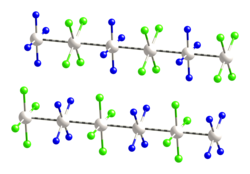This is an old revision of this page, as edited by 70.180.238.179 (talk) at 23:28, 10 January 2011 (improve). The present address (URL) is a permanent link to this revision, which may differ significantly from the current revision.
Revision as of 23:28, 10 January 2011 by 70.180.238.179 (talk) (improve)(diff) ← Previous revision | Latest revision (diff) | Newer revision → (diff)
| |

| |
| Names | |
|---|---|
| IUPAC name Tetraammineplatinum(II) tetrachloroplatinate(II) | |
| Identifiers | |
| CAS Number | |
| ECHA InfoCard | 100.034.078 |
| PubChem CID | |
| Properties | |
| Chemical formula | H12Cl4N4Pt2 |
| Molar mass | 600.09 |
| Appearance | green solid |
| Density | 3.7 |
| Melting point | 320 |
| Except where otherwise noted, data are given for materials in their standard state (at 25 °C , 100 kPa). Infobox references | |
Magnus' green salt is the chemical compound with the formula . This species has been of interest in materials chemistry and solid-state physics because of its one-dimensional structure. It contains a linear chain of alternating anions and cations, in which the platinum atoms are separated by 3.25 Å. It is a semi-conductor. The compound may be prepared by mixing aqueous solutions of and , to obtain a deep green precipitate.
Derivatives
In recent years, it has been possible to generate soluble polymers by replacing the ammonia with ethylhexylamine.
History
This salt was discovered by Heinrich Gustav Magnus in the early 1830s. It was one of the first examples of a metal complex of ammonia. Ammonia species are very common now; they were, after all, the basis of Alfred Werner's discoveries. Magnus' green salt has the same empirical formula as cis-PtCl2(NH3)2 ("Peyrone chloride") and trans-PtCl2(NH3)2. These cis and trans compounds are molecules, whereas Magnus' green salt is a polymer.
References
- Atoji, M.; Richardson, J. W.; Rundle, R. E. (1957). "On the Crystal Structures of the Magnus Salts, Pt(NH3)4PtCl4". J. Am. Chem. Soc. 79: 3017–3020. doi:10.1021/ja01569a009.
{{cite journal}}: CS1 maint: multiple names: authors list (link) - Caseri, W. (2004). "Derivatives of Magnus' green salt; from intractable materials to solution-processed transistors". Platinum Metals Rev. 48: 91–100. doi:10.1595/147106704X1504.
- Bremi, J.; Caseri, W. and Smith, P. (2001). "A new compound derived from Magnus' green salt: solid state structure and evidence for platinum chains in solution". J. Mater. Chem. 11: 2593–2596. doi:10.1039/b104675f.
{{cite journal}}: CS1 maint: multiple names: authors list (link)